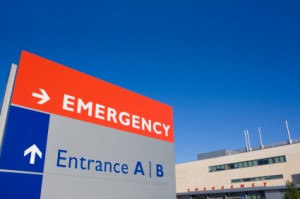Most emergencies aren’t predictable or preventable with any realistic consistency; things like choking, allergies, fire, snake bites, and bee stings are a fact of life and oftentimes difficult to avoid.
For someone who lives the off-the-grid lifestyle, self-reliance has become a big part of daily life. However, there are times when more comprehensive medical attention is necessary and unavoidable. For “everyday” emergencies, the nearest hospital, emergency facility, ambulance, or even life flight or community specialty operations are the norm and usually reasonably accessible.
But what about a major, widespread catastrophe?
What happens if major wildfire in the region threatens the hospital itself? How about a terrorist attack like that which occurred on September 11, 2001? How about pandemic? On the West Coast, you might have to worry about earthquakes and in the South, hurricanes. Every region has its own major crisis concerns.
 Did you know that on average, hospitals are only 20 percent of the size necessary to handle a major crisis event with injuries numbering in the lowest possible estimations? Most hospitals will be operating at over 500 percent capacity during a major event in a large metropolitan area. That number is staggering and invites those of us more inclined toward self-reliance to explore the numbers involved and look for ways to improve our reliance on emergency infrastructure, specifically hospitals.
Did you know that on average, hospitals are only 20 percent of the size necessary to handle a major crisis event with injuries numbering in the lowest possible estimations? Most hospitals will be operating at over 500 percent capacity during a major event in a large metropolitan area. That number is staggering and invites those of us more inclined toward self-reliance to explore the numbers involved and look for ways to improve our reliance on emergency infrastructure, specifically hospitals.
Firstly, we live in an on-demand society. Hospitals are no exception to this rule. In fact, you can see just how reliant we are as a society on overnight deliveries, warehousing centers, and transport logistics by looking at how fast store shelves empty during even the smallest emergencies or during times of heightened awareness by the society at large. You’ll notice that even though Wal-Mart seems to be stocked to the rafters, without excellent logistics to restock, shelves would be barren within hours or if you’re lucky, days. Hospitals only stock those supplies which they can reasonably expect to be using over the course of very short periods of time—sometimes less than a week. This is to help their balance sheets remain as liquid as possible and to maximize space, amongst other more minor reasons. In the event of a major influx of patients with supply lines potentially crippled, a hospital would be taxed far beyond its available supply levels (not to mention the amount of capacity it has from an organizational standpoint).
During major events, hospitals have proven that they are unable to service the population at large. Take Hurricane Katrina for example: Less than an hour after the hurricane lifted from the area, local hospitals were at capacity, with lines out the door. Not only was there havoc because of injuries, but also those without shelter had come to hospitals seeking refuge. Hospitals operate under a fixed set of variables including those which take into account physical space. Additionally, it’s near impossible for a hospital to rationalize sending people away or enforcing with minimal security a major amount of people (such as those in a mob or fleeing from the epicenter of a major event). Just because some hospitals were left standing during major events doesn’t mean that those hospitals wouldn’t be affected in other circumstances. Take for example the wildfires in Southern California, which hit multiple times in less than ten years, shutting down vast portions of the metropolitan area (San Diego, Riverside, Los Angeles). Oftentimes the fires were so dangerous or so uncontrollable that many hospitals had to be evacuated due to air quality conditions or safety concerns for patients or staff. Having to evacuate an already near-capacity hospital and relocate critical patients or otherwise active patients not only puts a stress on the regional system but makes it nearly impossible to avoid casualties and additional safety concerns.
Learn How You Can Make Powerful Herbal Medicines Secretly in Your Kitchen
During times of economic stress, which we are still experiencing, staffing shortages are also prevalent. Whether it is specialists working overtime or teams being downsized, staffing shortages can have huge impacts on the capacity of emergency and other medical facilities. Furthermore, during times of major crisis, many who would be able to serve as staff members are unable to due to transportation difficulties, infrastructure damage, or simply fear, not to mention personal casualties, injuries, or sickness.
Did you know that 90 percent of all hospitals with emergency facilities are at over 90 percent capacity 90 percent of the time? Private industry imposes very strict constraints on management teams to maintain profitability (for obvious reasons), which further degrades the capacity of those institutions to serve the full public during major events. Some emergency management experts predict that during a major event comparable to Hurricane Katrina, a local hospital would have less than two hours’ worth of supplies, and that’s just factoring in the emergency influx—hence the practice of triaging.
Long-term patients—for instance, cancer patients—require active pharmaceuticals, which often have tiny shelf loads; diabetic patients and those requiring certain antibiotics have specific needs for refrigeration and other storage applications for prescriptions. During a sustained event, backup generators may not make it through the need cycle.
Did you know that over 230 life-saving drugs are at “scarce” levels? Keep in mind that we are not experiencing a current epidemic, pandemic, or wartime effort on our soil. Essentially our government does not have enough drugs to keep everyone alive for more than a couple of weeks.
Of course, as those who live off the grid know, being reliant on government isn’t exactly our strongest suit. But what should you do in the event of a widespread catastrophe?
Unless absolutely necessary, you should probably consider avoiding emergency rooms. For instance, a simple broken bone (as opposed to a complicated compound fracture or exposed bone), minor burns, cuts, or limb trauma could probably be treated at home or with the help of neighbors instead of attempting to go to the hospital where one would be simply triaged down the list and forced to wait anyway.
Where possible, head trauma, profuse bleeding, large open wounds, major burns, obvious needs for antibiotics, or allergic reactions should be cause for immediate concern and a trip to the emergency room. Those without medical supplies who could easily become incapacitated, severely injured, or sick as a result of lack of medication should also consider going to the hospital. A major factor in this determination will be your good judgment. Anything that seems well beyond your scope of handling should be considered enough concern to demand treatment at the hospital. For those already living the off-the-grid lifestyle, these words probably ring true enough, as many of you already live in such a way that doesn’t allow slight discomfort to dictate a surrendering of your own self-reliance or good judgment. If you are alone and have experienced a traumatic event that could lead to shock or other complications, explain your situation to the nearest person capable of executing an emergency plan. During times of widespread catastrophe, no matter how self-reliant we are, it will always be important to be able to communicate and to rely on infrastructure that is in place for such events.
While it is true that hospitals are overcapacity during major concerns, society has a way of coming together to ensure that citizens can emerge alive and well; do not be afraid to take advantage of infrastructure and local community should the need arise, but do not go into such a scenario disillusioned.
©2012 Off the Grid News












